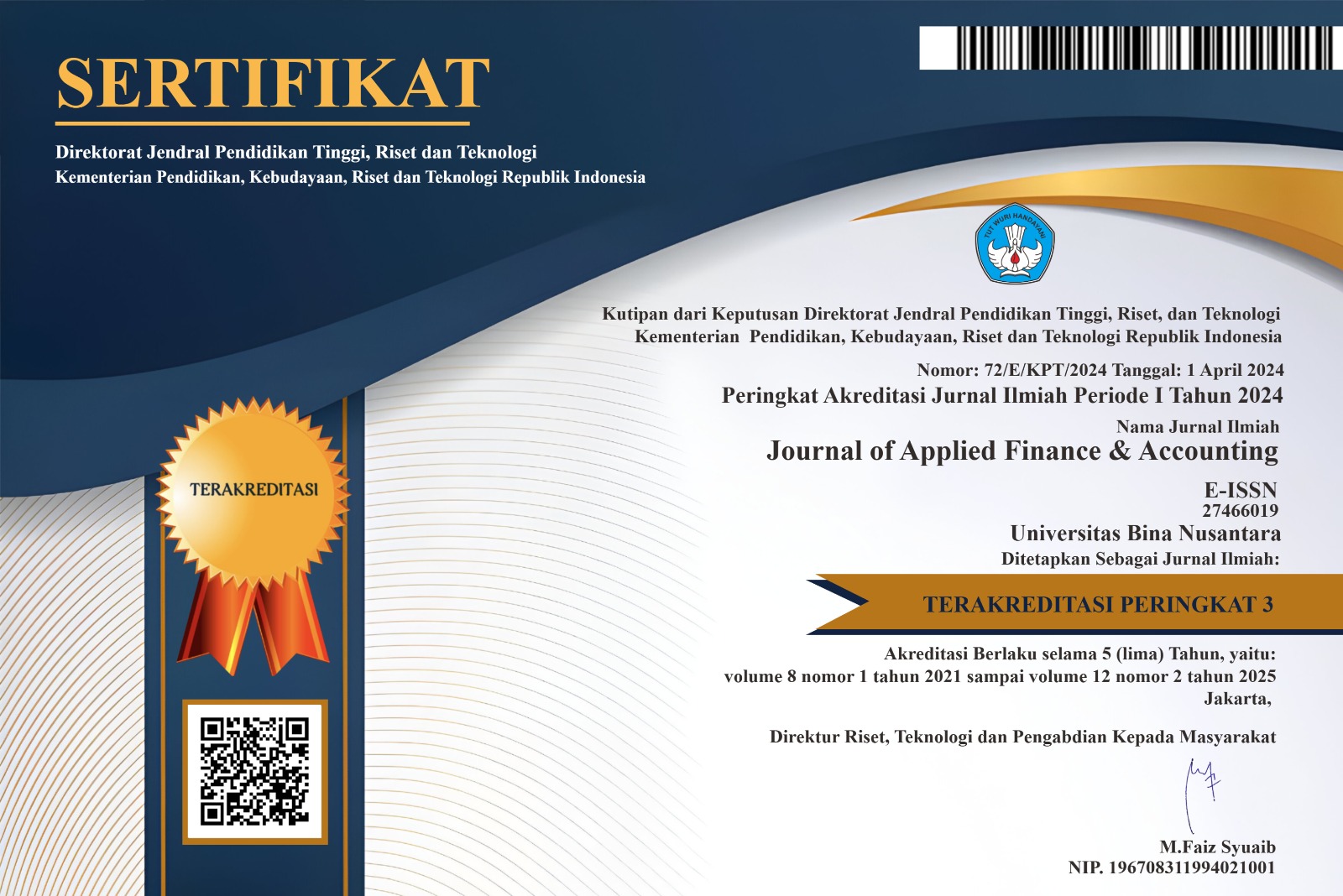UNDERSTANDING THE INTERPLAY OF FIRM SIZE, AUDIT FEES, AND AUDIT FIRM SIZE IN SHAPING FINANCIAL REPORT QUALITY: EMPIRICAL EVIDENCE FROM ASEAN COUNTRIES
DOI:
https://doi.org/10.21512/jafa.v11i1.10806Keywords:
ASEAN, Audit Fees, Audit Firm Size, Financial Report Quality, Firm SizeAbstract
This study investigates the impact of firm size, audit fees, and audit firm size on financial report quality, along with examining variations in financial report quality across ASEAN countries. A sample of 164 manufacturing companies listed in ASEAN countries during the 2018-2021 period was selected using a purposive sampling method. Pooled data regression and Kruskal-Wallis nonparametric analysis were employed for data analysis. The findings reveal that firm size and audit fees have a significant negative influence on financial report quality, while audit firm size does not exhibit a significant effect. Furthermore, notable variations exist in the quality of financial reports among ASEAN countries. These results provide empirical evidence that auditing services alone do not enhance financial report quality, underscoring the need for practitioners, academics, and regulators to undertake necessary measures for improving the quality of companies' financial reports.
References
Bova, F., & Pereira, R. (2012). The determinants and consequences of heterogeneous IFRS compliance levels following mandatory IFRS adoption: Evidence from a developing country. Journal of International Accounting Research, 11(1), 83-111.
Carey, P., & Simnett, R. (2006). Audit partner tenure and audit quality. The Accounting Review, 81(3), 653-676.
Cristansy, J., & Ardiati, A. Y. (2018). Pengaruh kompleksitas perusahaan, ukuran perusahaan, dan ukuran kap terhadap fee audit pada perusahaan manufaktur yang terdaftar di bei tahun 2012-2016. Modus, 30(2), 198–211.
Dang, C., (Frank) Li, Z., & Yang, C. (2018). Measuring firm size in empirical corporate finance. Journal of Banking & Finance, 86, 159–176. https://doi.org/10.1016/j.jbankfin.2017.09.006
DeAngelo, L. E. (1981). Auditor size and audit quality. Journal of Accounting and Economics, 3(3), 183-199
Dye, R. A. (1991). Informationally motivated auditor replacement. Journal of Accounting and Economics, 14(4), 347-374.
Fashiur, Rahman., Siti, Zaleha, Abdul, Rasid., Sarfraz, Nahid, Hussain. (2023). The Influence of Audi Fees in the Nexus Between Corporate Sustainability Engagement and Earnings Management. International Journal of Professional Business Review, 8(3):e01079-e01079. doi: 10.26668/businessreview/2023.v8i3.1079
Ghozali, I. (2016). Aplikasi Analisis Multivariete Dengan Program IBM SPSS 23. Badan Penerbit Universitas Diponegoro.
Hay, D., Knechel, W. R., & Wong, N. (2006). Audit fees: A meta-analysis of the effect of supply and demand attributes. Contemporary Accounting Research, 23(1), 141-191
Ishak, R., Amran, N. A., & Abdul Manaf, K. B. (2018). Firm Characteristics and Financial Reporting Quality: The Moderating Role of Malaysian Corporate Governance Index. The Journal of Social Sciences Research, SPI6, 924–932. https://doi.org/10.32861/jssr.spi6.924.932
Jensen, M. C., & Meckling, W. H. (1976). Theory of the firm: Managerial behavior, agency costs, and ownership structure. Journal of Financial Economics, 3(4), 305–360. https://doi.org/10.1016/0304-405X(76)90026-X
Kautsar, Riza, Salman., Bety, Setyaningrum. (2023). The Effects of Audit Firm Size, Audit Tenure, and Audit Rotation on Audit Quality. Ilomata International Journal of Tax and Accounting, 4(1):92-103. doi: 10.52728/ijtc.v4i1.636
Knechel, W. R., Krishnan, G. V., Pevzner, M., Shefchik, L. B., & Velury, U. K. (2013). Audit quality: Insights from the academic literature. Auditing: A Journal of Practice & Theory, 32(Supplement 1), 385-421.
Lubis, I. P., Fujianti, L., & Amyulianthy, R. (2019). Pengaruh Ukuran KAP, Ukuran Perusahaan dan Manajemen Laba terhadap Integritas Laporan Keuangan. ULTIMA Accounting, 10(2), 138–149. https://doi.org/10.31937/akuntansi.v10i2.993
Mirza, A., Malek, M., & Abdul-Hamid, M. A. (2019). Value relevance of financial reporting: Evidence from Malaysia. Cogent Economics & Finance, 7(1), 1651623. https://doi.org/10.1080/23322039.2019.1651623
Pham, N. K., Duong, H. N., Pham, T. Q., & Ho, N. T. T. (2017). Audit Firm Size, Audit Fee, Audit Reputation and Audit Quality: The Case of Listed Companies in Vietnam. Asian Journal of Finance & Accounting, 9(1), 429. https://doi.org/10.5296/ajfa.v9i1.10074
Pratama, N. R., & Juliarto, A. (2021). PENGARUH KONVERGENSI IFRS TERHADAP KUALITAS INFORMASI AKUNTANSI DENGAN COUNTRY BUSINESS ENVIRONMENT SEBAGAI VARIABEL MODERATING. Diponegoro Journal of Accounting, 10(4), 1–9.
Ramdani, R. F. (2020). Bentuk Penerapan International Financial Reporting Standard (IFRS) Di Negara Anggota Asean. JEMMA (Journal of Economics, Management, and Accounting), 3(2), 146. https://doi.org/10.35914/jemma.v3i2.428
Ranosa, R. and R., Ramadhan, F., & Djuitaningsih, T. (2022). PENGARUH MEKANISME CORPORATE GOVERNANCE, UKURAN KANTOR AKUNTAN PUBLIK, DAN INDEPENDENSI AUDITOR TERHADAP KUALITAS LAPORAN KEUANGAN. Media Riset Akuntansi, 9(2), 243–262.
Ridzky, M., & Fitriany, F. (2022). The Impact of Abnormal Audit Fees on Audit Quality: A Study of ASEAN Countries. KnE Social Sciences. https://doi.org/10.18502/kss.v7i12.11544
Syarli, Z. A. (2021). PENGARUH LEVERAGE, LIKUIDITAS, PROFITABILITAS, UKURAN PERUSAHAAN, UMUR PERUSAHAAN, DAN KUALITAS AUDIT TERHADAP KUALITAS LAPORAN KEUANGAN PERUSAHAAN. Bussman Journal: Indonesian Journal of Business and Management, 1(3), 314–327.
Watts, R. L., & Zimmerman, J. L. (1983). Agency problems, auditing, and the theory of the firm: Some evidence. Journal of Law and Economics, 26(3), 613-633
Downloads
Published
Issue
Section
License
Authors who publish with this journal agree to the following terms:
Authors retain copyright and grant the journal right of first publication with the work simultaneously licensed under a Creative Commons Attribution License that allows others to share the work with an acknowledgement of the work's authorship and initial publication in this journal.
Authors are able to enter into separate, additional contractual arrangements for the non-exclusive distribution of the journal's published version of the work (e.g., post it to an institutional repository or publish it in a book), with an acknowledgement of its initial publication in this journal.
Authors are permitted and encouraged to post their work online (e.g., in institutional repositories or on their website) prior to and during the submission process, as it can lead to productive exchanges, as well as earlier and greater citation of published work (See The Effect of Open Access).





